Chinese vs Vietnamese food? Both of them are incredibly delicious and diverse. If you are a fan of Asian cuisine, you should not miss a chance to taste Chinese and Vietnamese foods. They will not fail to satisfy your tastebuds, I’m sure.
As neighboring countries, China and Vietnam may have some similarities in their cuisine. However, they also have impressive culinary features which make them distinctive. Let’s scroll down to learn everything about Chinese and Vietnamese foods.
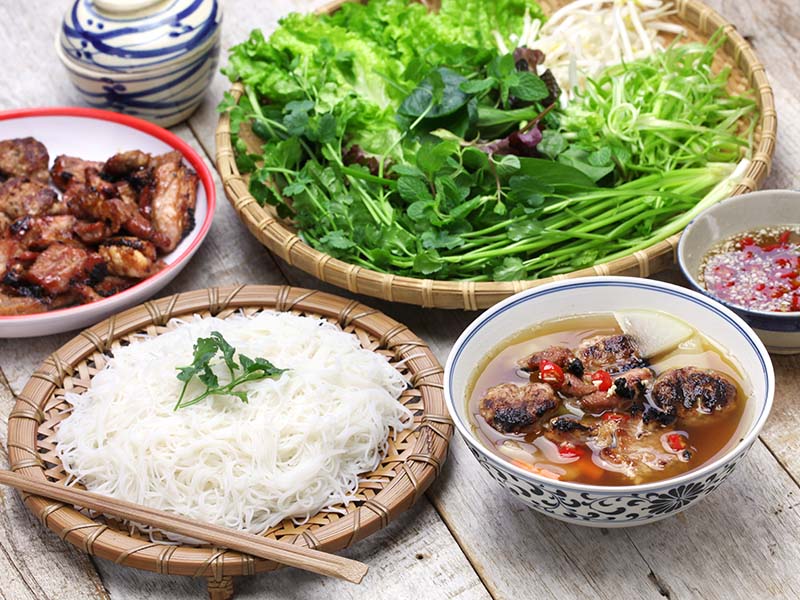
An Overview Of Famous Chinese Food
China, or the People’s Republic of China, located in East Asia, is the most populous country in the world. It is undeniable that this country has a long-standing history. It reflects in the diverse culture, magnificent architecture, and incredible cuisine.
Key Elements And Ingredients
Chinese food revolves around three key elements: color, fragrance, and taste. If you look at a Chinese table, you will see that the foods are diverse, from plain to colorful dishes. The main staple ingredients in Chinese foods are rice, wheat, and noodles.
Rice is the main staple in Southern China, while the North favors wheat. You may find a wide variety of Chinese noodles with different shapes and textures.
One of the most popular noodles in China is Longevity Noodles (Shou Mian). The locals serve it during the Chinese New Year and birthdays as a wish for longevity.
Moreover, herbs and spices play an integral part in Chinese cuisine. Although the Chinese recipes use similar ingredients, the chefs use different cooking techniques, herbs, and spices to create different properties.
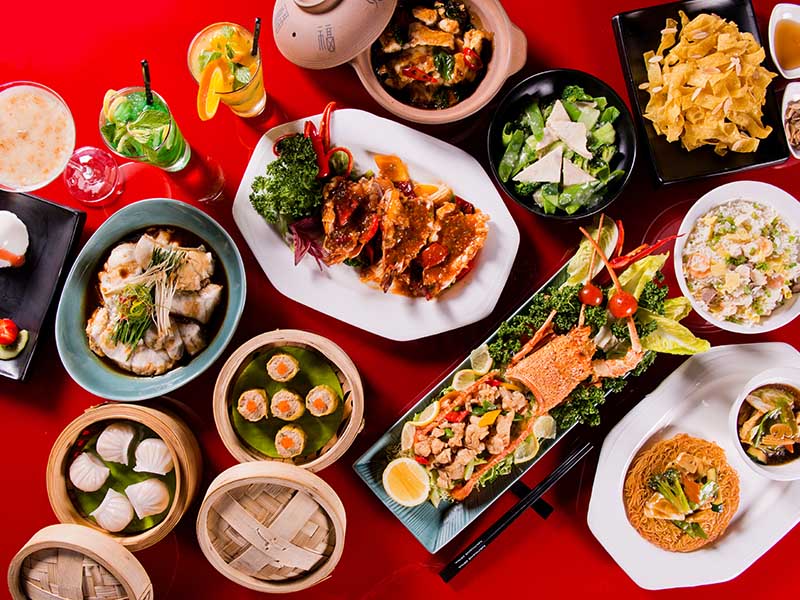
Regional Cuisines
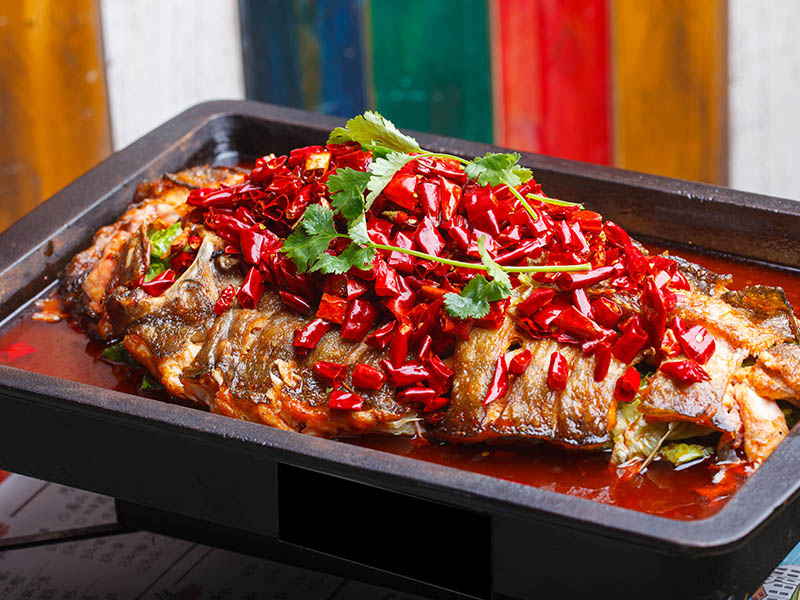
Currently, there are eight well-known regional cuisines in China. Each has unique features with representative dishes.
Cantonese or Guangdong or Yue cuisine prefers keeping the original taste of food, so they avoid using too much sauce or spices. A typical Cantonese dish is Dim Sum.
Sichuan or Szechuan cuisine is well-known for spicy and strong-flavored foods. The most popular dish is Sichuan Hot Pot, which is many people’s favorite.
Anhui dishes focus on the use of wild herbs. They prefer braising and stewing cooking methods rather than frying and stir-frying. One of the most famous dishes in this region is hairy-tofu.
Shandong or Lu cuisine is famous for its seafood. The expert cooking methods are quick frying (bao), quick frying with corn flour (liu), stewing (pa), roasting (kao), and boiling (zhu).
Fujian, also known as Fujianese cuisine or Min cuisine, prefers soup or broth in a meal. Seafood is also a key ingredient in this region. Buddha Jumps Over Wall is one of the most famous dishes in Fujian cuisine.
Jiangsu or Su cuisine flavor is umami, natural with the rich original flavor of the ingredients. Controlling fire heat, food carving, and cutting are the special features of the region. Sweet And Sour Mandarin Fish is a typical dish in Jiangsu cuisine.
Hunan or Xiang cuisine is well-known for hot and spicy foods. But it prefers fresh chili and other ingredients rather than dried chili in Sichuan cuisine. Hunan use smoked and cured goods in foods frequently.
Zhejiang cuisine has a fresh and light taste and nearly keeps the original flavor of ingredients. One of the notable dishes is West Lake Fish in Vinegar Gravy.
Chinese foods and Chinese-inspired dishes are becoming more and more popular in many countries all around the world.
Here is an overview of the eight regional cuisines in China.
Special Things About Incredible Vietnamese Food
Vietnam is a Southeast Asian country and a neighbor of China to the South. Even though Vietnam is not a prosperous country, it is still a must-see destination in Asia.
If you have a chance to visit Vietnam, you will fall in love with its breathtaking natural beauty, diverse culture, hospitality, and impressive cuisine. Most Vietnamese dishes win the heart of many people at their first bite.
Preference For Fresh Vegetables And Herbs
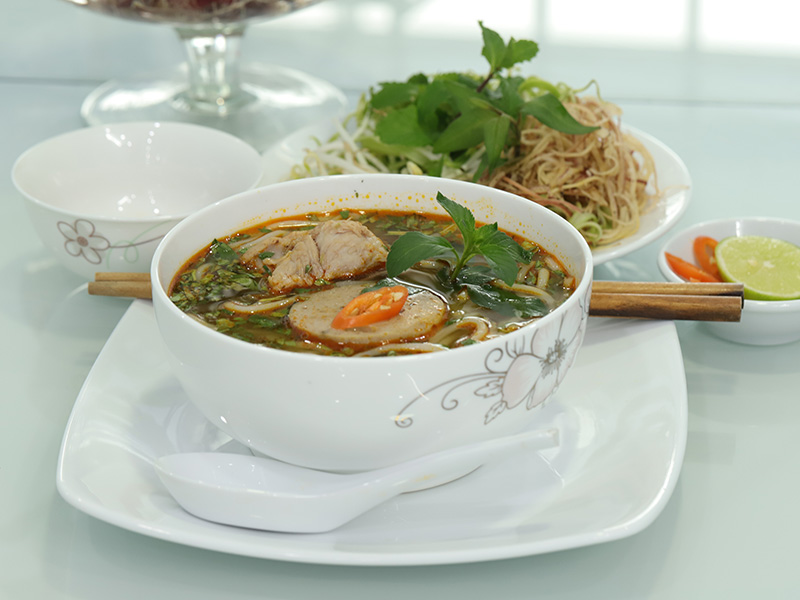
One of the reasons why people consider Vietnamese foods health-conscious is the fresh vegetables and herbs used. Most of the dishes in Vietnam include fresh vegetables such as bean sprouts, lettuce, mint, coriander, and green onions.
When you eat in Vietnamese street food vendors or restaurants, there is usually a vegetable plate coming along. There are also limes and fresh chili peppers.
Regional Cuisines
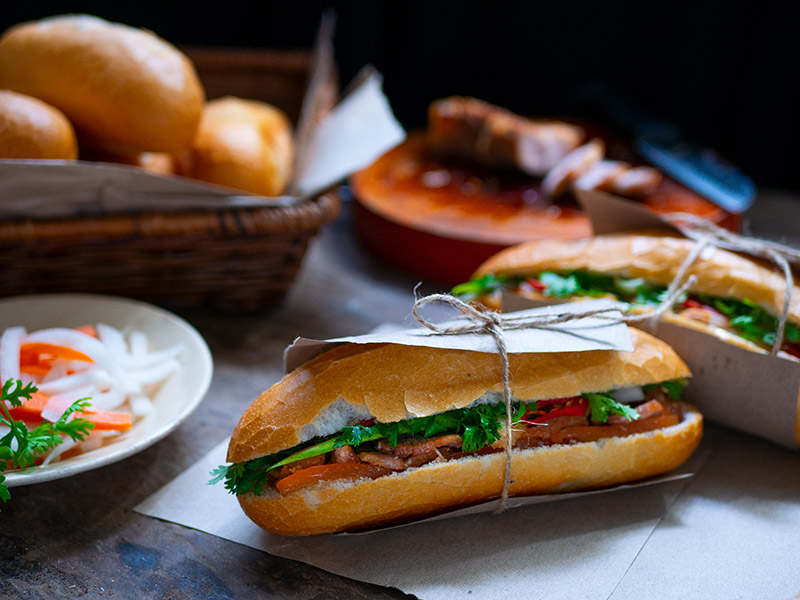
Vietnam has three main regions of cuisine. Each region has its distinctive characteristics and delicious dishes you can not resist. You may hear people compare the foods between Northern and Southern Vietnam, but actually, there are three different regions.
Northern cuisine is sophisticated with light and savory flavor. It also focuses more on food decoration and culinary manners than the other two regions. Pho is the most famous in the North and also the most internationally recognized dish.
Central cuisine is famous for its strong and spicy flavor. The dishes in Central Vietnam are diverse, from Royal food to street food. Once you try the foods there, you will not forget their special taste. Bun Bo Hue is the most famous dish in this region.
Southern cuisine prefers a sweet flavor, so the foods there are usually sweeter than the others. The foods there are more diverse since Southern Vietnam is a multicultural area in Vietnam. Hu Tieu Nam Vang is one of the most popular dishes in this land.
Vietnamese cuisine is diverse in three regions, and it is more than Pho.
Similarities Between Chinese and Vietnamese Food
China and Vietnam are geographically close. Besides, in the past, Vietnam used to be under Chinese colonization for over 1000 years. These are two main reasons why there are some similarities between Chinese and Vietnamese cuisine.
Main Staple
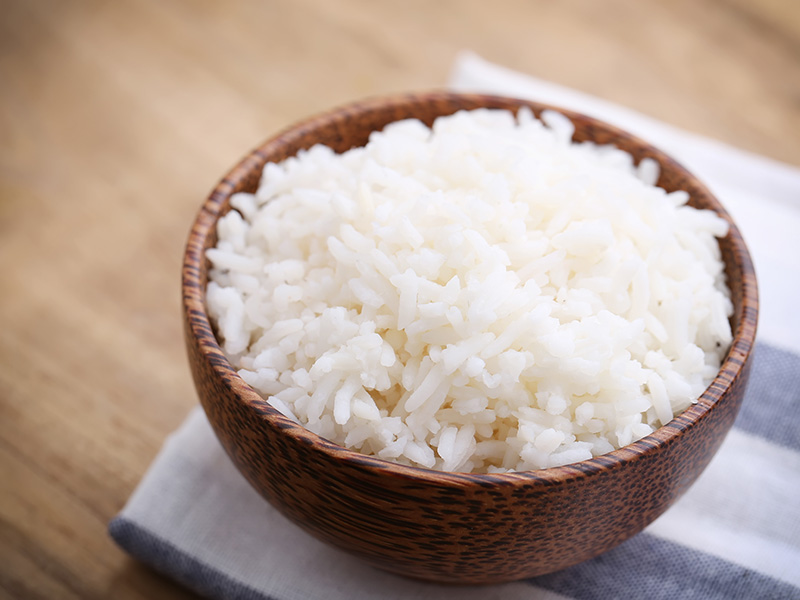
Vietnam and China are two of the top rice-producing countries (1). Thus, it is no doubt that rice is the main staple in Chinese and Vietnamese cuisine. Steam rice, fried rice, and rice porridge are popular in both countries.
However, Vietnamese people cultivate rice all around the country, while it is more popular in Southern China than in the North. In Northern China, people cultivate and consume wheat the most. It is the main ingredient in Chinese noodles, bread, dumplings, and buns.
The Vietnamese also consume wheat but much less than rice. Because the climate of Vietnam is not suitable for cultivating wheat, Vietnam has to import wheat from foreign countries.
Another similar staple for both China and Vietnam is noodles. Noodle dishes play an integral part in the cuisine of the two countries. You can find a huge number of noodle dishes in China and Vietnam.
Some famous noodle dishes in China are Beijing Soy Bean Paste Noodles, Lanzhou Beef Noodle Soup, and Chongqing Noodles. In Vietnam, Pho, Hue Beef Noodle, and Nam Vang Noodle are some typical noodle dishes.
Rice plays a crucial role in everyday life of Chinese people.
Main Ingredients
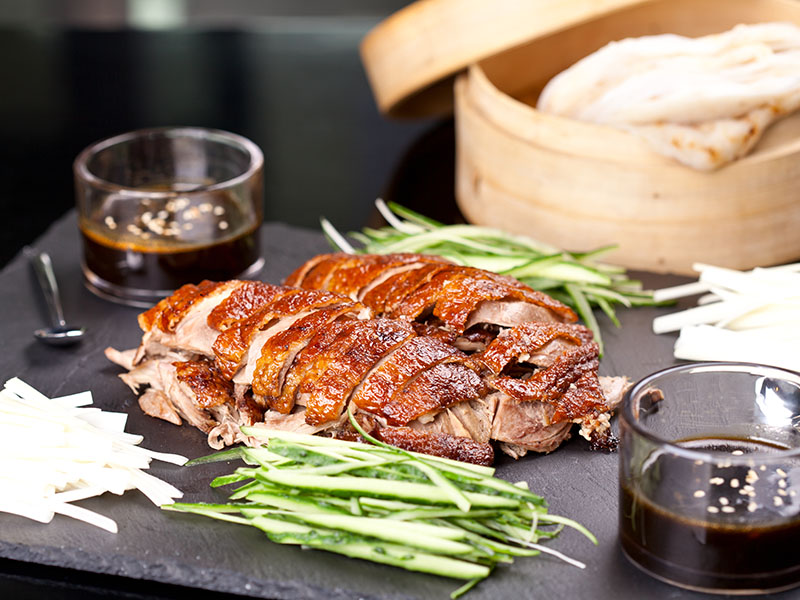
There is no limitation on the main ingredients for the foods in Vietnam and China. The locals make many delicious dishes from meat such as pork, beef, chicken, and duck.
Bun Cha (Vermicelli With Grilled Pork), Bun Dau Mam Tom (Fermented Shrimp Paste With Fried Tofu And Rice Vermicelli), and Cao Lau Noodle are some iconic Vietnamese meat dishes. In China, they are Sweet And Sour Pork, Peking Duck, and Kung Pao Chicken.
Both China and Vietnam are countries bordering seas, so fresh fish and seafood are also favored ingredients in their cuisine. You can try Crab Noodle Soup, Rice Vermicelli With Jellyfish and Fish in Vietnam, and Chinese Mitten Crab, West Lake Vinegar Fish in China.
Five Essential Flavors And Their Relationship With Five Organs
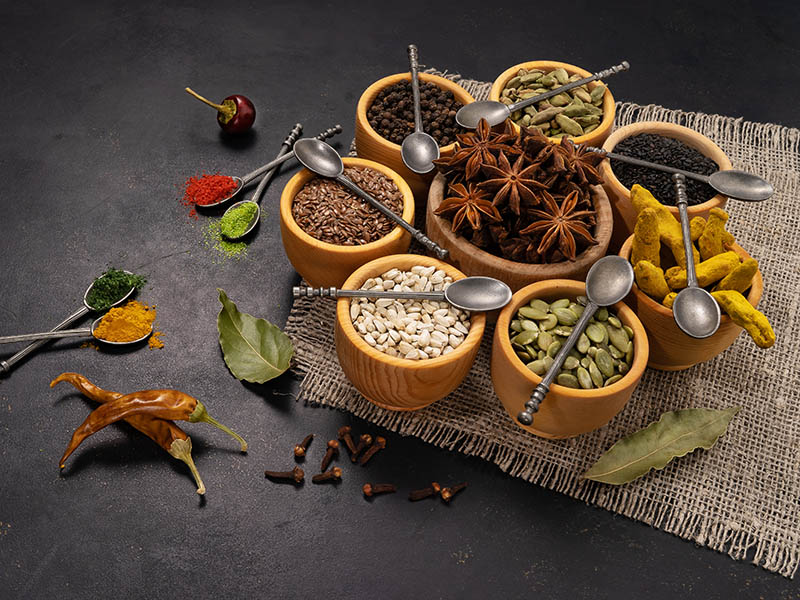
In Chinese and Vietnamese cuisine, there is a concept called five flavors (ngũ vị or 五味) or the relationship between five flavors with five organs in the human body: sourness – liver, spiciness – lung, saltiness – kidney, sweetness – spleen, and bitterness – heart.
They believe that each flavor connects and affects a specific organ. If one consumes a flavor too much or suddenly craves a flavor, it is a sign that a certain organ is in disorder. With this belief, the Chinese and Vietnamese people tend to balance the flavors in their everyday meals.(2)
Similar Cooking Methods
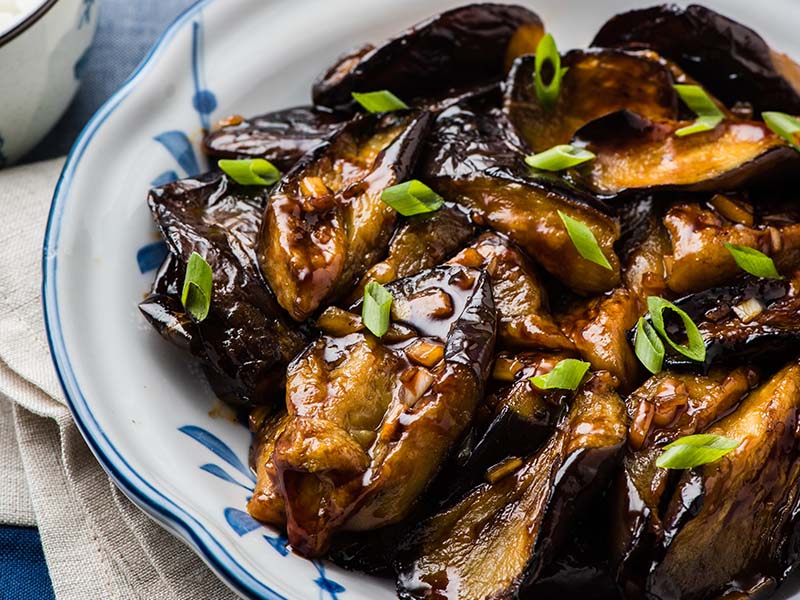
Another similarity between these two Asian cuisines is the cooking methods. Both Vietnamese and Chinese culinary techniques are diverse and quite similar to each other.
Both have many tasty dishes cooked in different methods such as stir-frying, deep-frying, stewing, braising, steaming, and boiling.
One of the most essential cooking utensils in both countries is the large oval pan (Chinese wok), which the locals often use to stir-fry or deep-fry foods.
Dining Etiquette
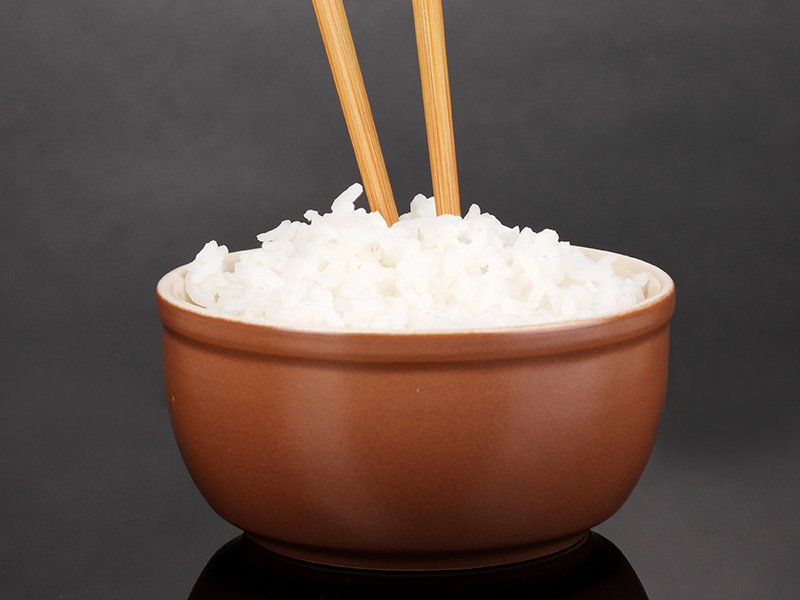
Although dining etiquette can be different depending on the region, China and Vietnam share some customs and etiquette in dining.
First, in Chinese and Vietnamese meals, dishes are shared. Normally, they place all of the dishes on a round tray, and everyone will sit around it and share the food. Each person will have a bowl of white steamed rice, and they eat the rice with the food.
Besides, both Chinese and Vietnamese people consider finishing all the food in your bowl in good manners. It is not wasteful and shows your respect to the cook and the farmers.
As chopsticks are the main utensils in both countries, there are some similar manners in using chopsticks. It is rude to use chopsticks to point at people.
Besides, you should never stick your chopsticks into your rice bowl vertically. Since it is similar to the incense burned at funerals, it may bring bad luck.
What Makes Chinese and Vietnamese Cuisine Different?
So, are you ready to discover the differences between Chinese and Vietnamese food? They do have their unique features, which make them delicious and irreplaceable.
Origin And Foreign Influences On The Cuisine
The first difference between Chinese and Vietnamese cuisine is the foreign influences.
Chinese Food
Chinese cuisine evolved over many periods and dynasties. It also adopted recipes, ingredients, and cooking methods from Japanese traders and Europe missionaries. Therefore, people may find differences in Chinese cuisine when compared to Japanese, another popular Asian cuisine.
Chopsticks initially were not the cooking utensils in China until the Han Dynasty. However, it became common for serving and eating in the Ming dynasty.
Also, during the Ming dynasty, the Chinese purchased sweet potatoes and peanuts from the Spanish Empire to cultivate in extreme lands where rice and wheat could not develop.
To your surprise, some popular ingredients now in China are actually imported. For example, the West introduced sesame, onions, coriander, and cucumber into China during the Han dynasty.
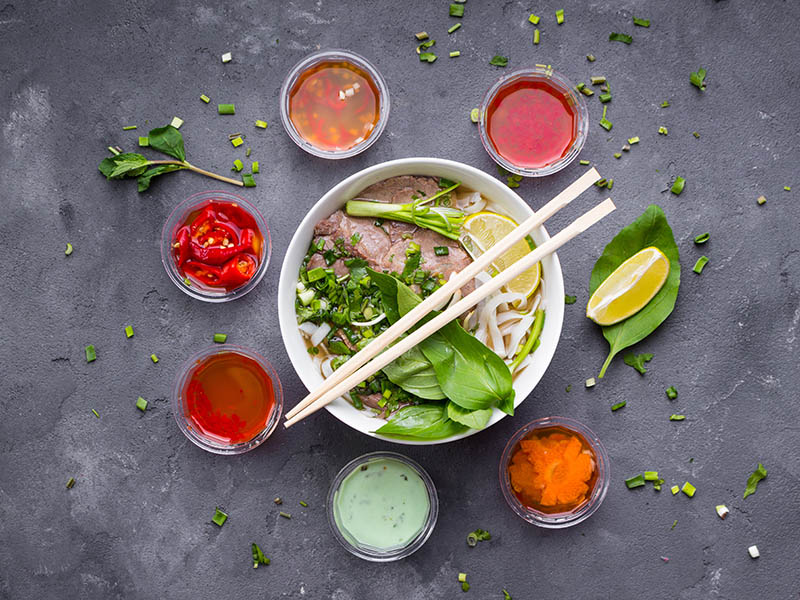
Vietnamese Food
The cuisine in Vietnam absorbs culinary ideas from other countries like China, France, Champa, Malaysia, and Cambodia.
The Chinese brought several dishes to Vietnam, such as steamed buns, wonton, and Yangzhou fried rice. The Vietnamese adopted and altered these foods to suit the appetite of local people.
Some Northern Vietnamese ethnic minorities, such as Tày or Nùng, adopted Roasted Pork and Braised Pork Belly from China. During the Ming dynasty, chili peppers and corn also arrived in Vietnam.
Because France used to occupy and rule Vietnam, it influenced Vietnamese cuisine. There are many French-inspired dishes in Vietnam, including Banh Mi, Salad, Omelet, and Beefsteak.
Since the French brought their baguettes into Vietnam, the Vietnamese have altered and turned them into famous Vietnamese sandwiches.
The influence of Champa on Vietnamese cuisine reflects in the use of coconut milk and some other dishes. Malaysia and Indian traders introduced curries to Vietnam. It later became a common dish in Central and Southern Vietnam.
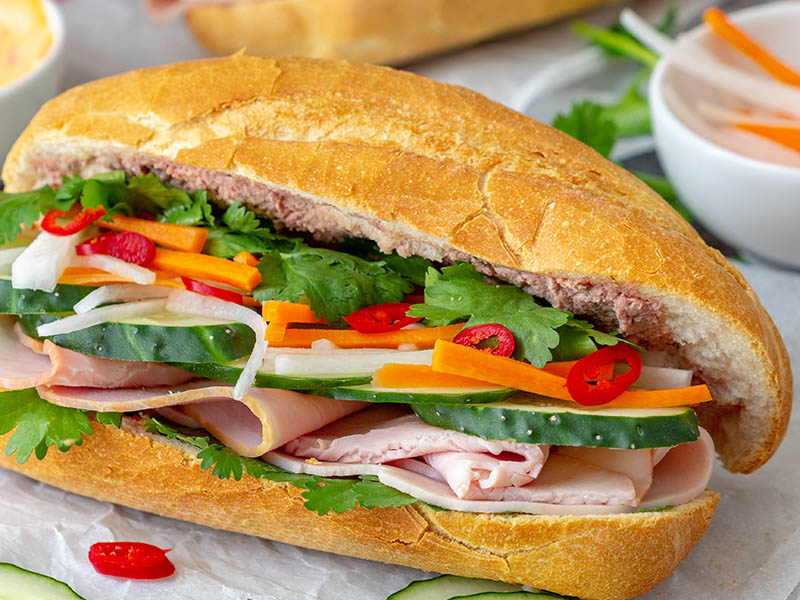
Soup
Soup plays an important role in both Chinese and Vietnamese cuisine.
Chinese Food
In China, the local people in the South eat soup between the cold and the main dishes. Whereas in other places, they serve soup before desserts or fruits. The soup in China requires much attention and exquisite techniques.
Chinese soup is nutrient-rich and usually aids in recovery from illness. One of the typical healthy Chinese soups is Chicken Herbal Soup which is beneficial for the digestive system and boosts immunity. If you use a slow cooker, it usually takes 4 to 5 hours to cook it.
In addition, the country also has a wide variety of sweet soups for desserts or appetizers. They are usually cooked from refreshing Chinese fruits, such as jujubes and pears, and a few other nutritious ingredients. Many have a cooling effect and are especially popular in summer.
You can learn how to cook this health-conscious Chicken Herbal Soup here.
Vietnamese Food
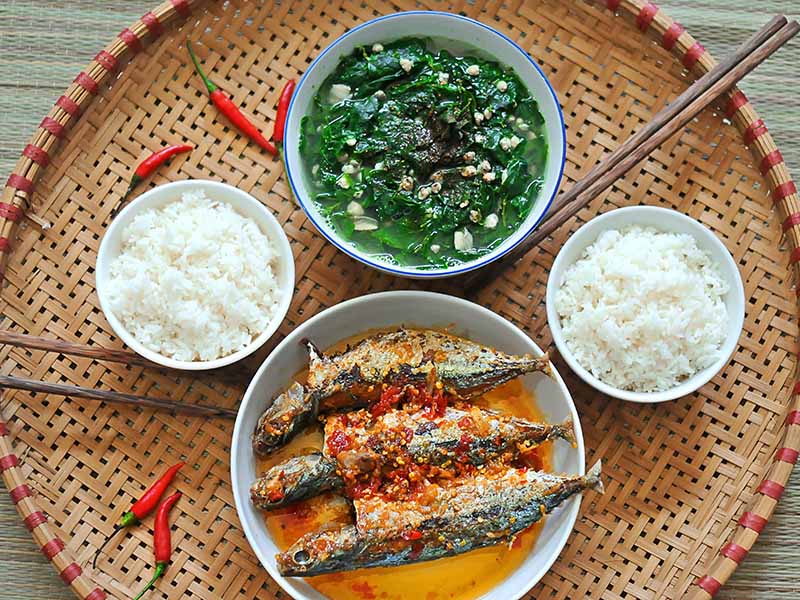
In Vietnam, there are two types of soup: noodle soups and broths (or canh in Vietnamese). Noodle soups are the essence of many famous dishes in Vietnam, including Phở, Bún Bò Huế, and Mì Quảng.
The locals normally simmer pork or beef bones with other ingredients for hours to cook the soup. It usually takes a long time to cook authentic, healthy, and delicious noodle soup.
In contrast, broths are one of the main dishes in the everyday meals of the Vietnamese. They usually serve it with steamed rice for lunch or dinner. Some typical broths are Canh Chua Cá Lóc (Sour Soup With Snakehead Fish) and Canh Rau Muống (Water Spinach Soup).
Vegetables
Vegetables are common ingredients in Chinese and Vietnamese cuisine. However, there is an obvious difference between the two. The Vietnamese love eating raw vegetables, while the Chinese prefer cooked veggies.
Chinese Food
In China, green beans, peas, and mushrooms are widely varied due to the different weather and soil conditions. In dried and colder areas in China, it is hard for fresh vegetables to develop. Therefore, they process them into dried and pickled vegetables.
Vietnamese Food
From the North to the South, most Vietnamese dishes include raw vegetables. You can see that in some Vietnamese specialties such as Pho, Hue Beef Noodles, Cao Lau Noodle, and Banh Xeo (Vietnamese Crepe).
The preference for raw vegetables makes Vietnamese food health-conscious. The greens also add fresh flavor and crunchy texture to the foods.
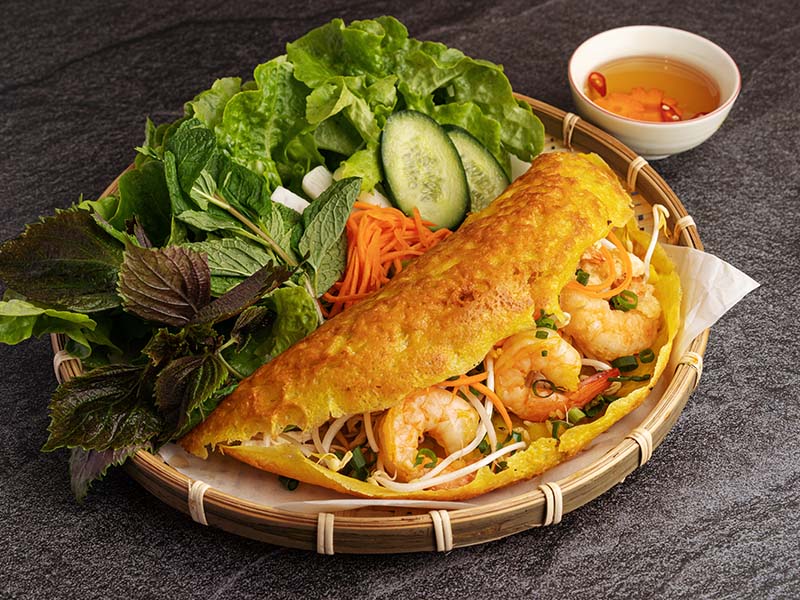
Accompanied Sauce
One more clear difference is about the sauce. The Vietnamese use fish sauce in their everyday meals, while the Chinese prefer soy sauce.
Fish sauce plays an important ingredient in cooking, and people also serve a small bowl of fish sauce on the table. On the other hand, soy sauce is much more popular in China, and it is an indispensable ingredient in Chinese cuisine.

Healthy Food
In general, Chinese foods are less healthy than Vietnamese foods. Because Chinese foods contain more fat, sodium, and calories, they may be quite unhealthy. If you want to enjoy healthier Chinese foods, consider dishes with less oil or steamed dishes.
On the contrary, Vietnamese cuisine is one of the healthiest cuisines in the world. The foods of Vietnam tend to have a balance of carbohydrates, proteins, minerals, and lipids. This is mostly because of the appearance of fresh vegetables and herbs in most dishes.
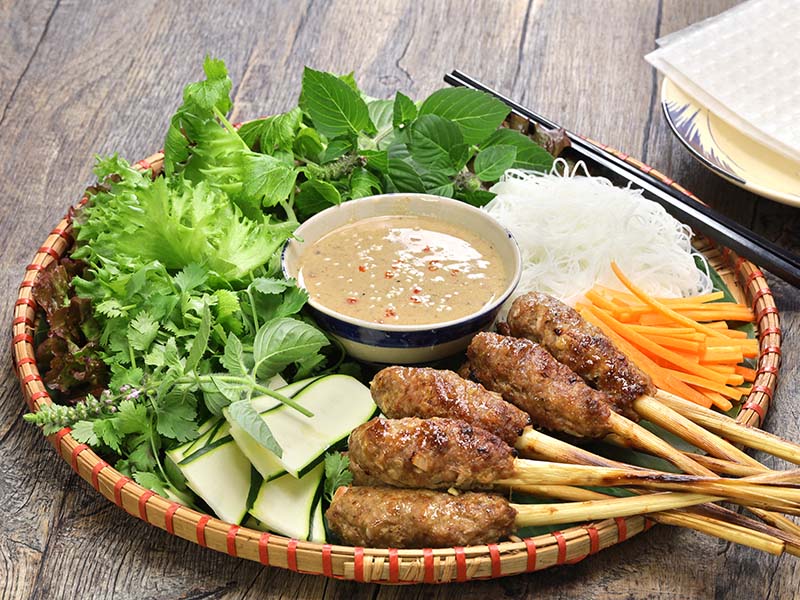
Beverages
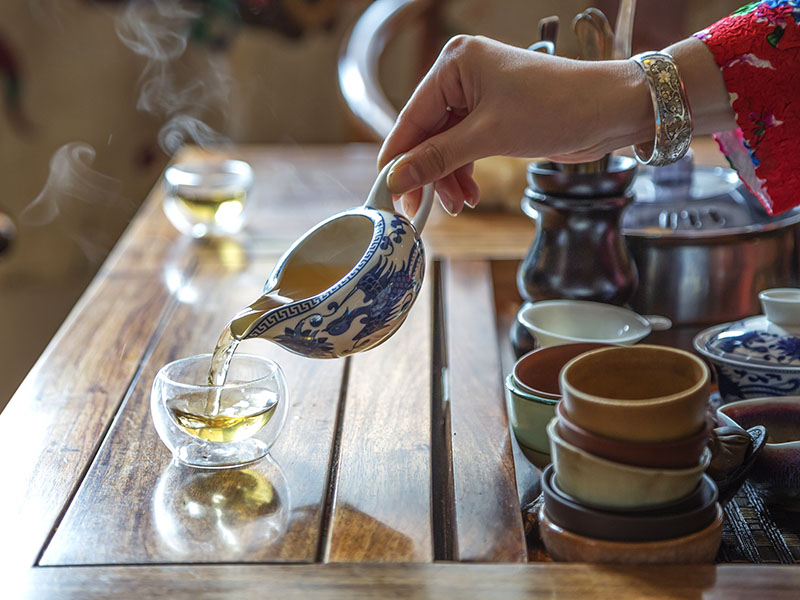
The beverages in both China and Vietnam are diverse. They play an important role in the cuisine of the two countries.
Chinese Beverages
Tea plays a crucial role in Chinese cuisine. China was the first country to grow and drink tea, so the tea-drinking tradition began a long time ago in China. There are many types of amazing Chinese tea, including black, green, white, yellow, oolong, and dark tea.
Black tea is one of the most famous beverages in China. Black tea can keep its flavor for quite a long time, so it is the favorite of many Chinese people. People serve it during or after meals.
In addition, China ranks top green tea exporter, so unfermented green tea is also a favored drink among Chinese people. They can serve it with meals or even during the day. Drinking green tea brings many health benefits, such as anti-aging and cancer-preventing.
In addition to tea, the Chinese people also love Baijiu and Huangjiu – the two most famous alcoholic drinks in China.
Baijiu is a transparent liquor distilled from Sorghum, wheat, grain, or rice. Its alcohol by volume (ABV) is high, from 35 to 60 percent. Thanks to the popularity of Baijiu in the most populous country, it has become the most consumed alcoholic drink worldwide.
On the other hand, Huangjiu, also called yellow liquor, is brewed instead of distilled. People make it by mixing boiled grains, normally rice, with qū. Then it goes through saccharification and fermentation. Its alcohol by volume (ABV) is around 8 to 20 percent.
China is also famous for some herbal drinks made from Chinese medicinal herbs. You can also find Soy Milk, Almond Milk, Hawthorn, and Jujube common during Chinese meals.
Vietnamese Beverages
Traditionally, tea is one of the most popular drinks in Vietnam. They usually serve tea after Vietnamese meals, especially when guests visit their houses. The most favored tea types are green tea and artichoke.
However, nowadays, there are many more tea-based drinks in Vietnam. You may find lemon tea, bubble tea, peach tea, and more in most Vietnamese coffee shops or street vendors. Apart from tea, Vietnam is also famous for many other types of beverages.
Vietnamese Iced Milk Coffee is the signature drink of the nation. Many people fall in love with this combination of bitterness and sweetness. In addition, there is a variety of coffee in Vietnam. Some most popular types are Egg Coffee and Salt Coffee.
Another famous beverage in Vietnam is Draft Beer. Most Vietnamese people, especially Hanoians, love enjoying a glass of refreshing Draft Beer with some savory side dishes to relax after a long working day.
What’s more? Vietnam is also a paradise of healthy drinks made from mouth-watering Vietnamese fruits. Some popular healthy beverages you should look for in Vietnam are Fruit Smoothie, Sugarcane Juice, and Pennywort Juice.
Follow a traveler to see his first time trying the famous Vietnamese Egg Coffee in Hanoi.
Are These Pairs Of Chinese And Vietnamese Dishes Similar?
China and Vietnam have some similar dishes to each other. Let’s look at some typical pairs of similar dishes that you may find in China and Vietnam.
Vietnam Hot Pot Vs Chinese Hot Pot
Basically, Hot Pot includes a pot of soup that a heat source keeps it simmering on the table. They place the raw foodstuffs and ingredients around the pot so that the customers can put them into the hot soup to cook and eat instantly.
Hot Pot is one of the most popular dishes in both China and Vietnam, with many varieties. Depending on the variants, the taste of the soup and the ingredients are different.
Chinese Hot Pot
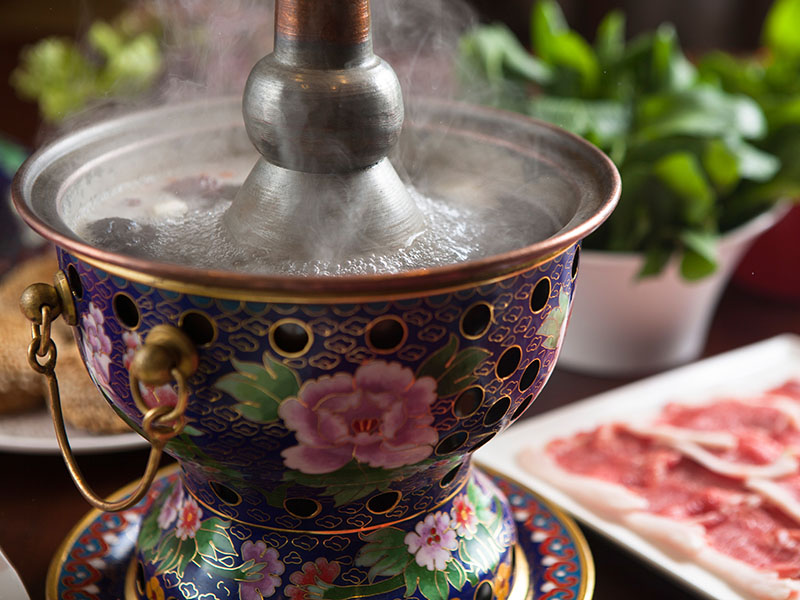
In China, despite wide regional variations, there are two main Chinese Hot Pot styles: The northern style and the Southern style.
Hot Pot in the North is simple and focuses on meat, especially mutton. Instant-boiled mutton is the iconic Northern style Hot Pot. Ingredients are more essential than the soup base in this style. They use water as the main ingredient in the Hot Pot instead of flavor broth.
In contrast, Southern-style Hot Pot has flavorful and spicy broth. They also focus more on complex dipping sauces and seafood. Chongqing and Sichuan Hot Pots are two signature Hot Pots in Southern China. Both of them are famous for their super high level of spice.
Normally, Chinese people dip all ingredients into hot soup and eat them. They also prefer wheat noodles. That is the difference between the way Chinese and Vietnamese people enjoy Hot Pot. You will find out about Vietnamese Hot Pot shortly after.
This extremely spicy Sichuan Hot Pot will numb your tongue.
Vietnamese Hot Pot
The Vietnamese call Hot Pot lẩu or cù lao. Vietnamese Hot Pot is similar to the Chinese one with the hot simmering soup on the table and the raw ingredients besides. There are many Hot Pot styles in Vietnam, including Lẩu Hải Sản (seafood) and Lẩu Mắm (salted fish).
The ingredients are fixed for each kind of Hot Pot. For example, if you go with the Spicy Beef Hot Pot, they will serve sliced beef, raw bitter melon, and other raw vegetables. The difference between Vietnamese and Chinese Hot Pots is the accompanied staple.
Vietnamese people prefer eating Hot Pot with rice vermicelli. They often pour the hot soup and other ingredients into their vermicelli bowls to enjoy.
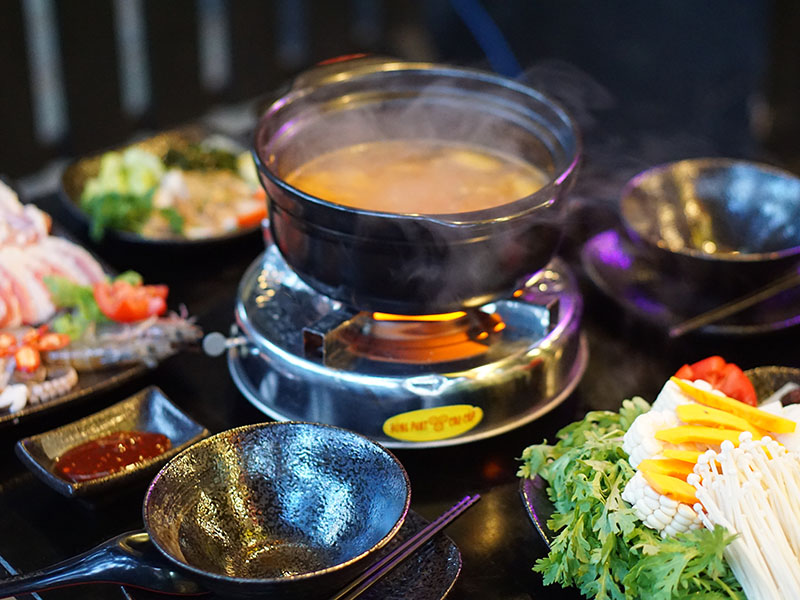
Vietnamese Buns Vs Chinese Buns
Steamed Buns (or Baozi) is a native dish of China. People make it from wheat, with or without fillings. The method to cook buns is steaming. Steamed Buns are a popular dish for breakfast in China and Vietnam.
Chinese Buns
In China, there are two main types of Baozi: Dàbāo and Xiǎobāo. Dàbāo has a bigger size and is a popular takeout. While smaller-sized Xiǎobāo mostly appears in restaurants, people also buy the takeaway versions. People usually serve Baozi with vinegar or soy sauce.
Cha Xiu Bao and Goubuli are the two most popular kinds of Baozi in China. Cha Xiu Bao is famous for its barbecue-flavored pork filling. Goubuli, also called Go Believe in English, is a famous brand of Baozi in Tianjin, China. Many people wait to buy it every morning.
Vietnamese Buns
Vietnamese Buns are an inspired dish by Chinese Dàbāo, which Cantonese immigrants brought to Vietnam. In general, they are round and larger than Chinese Baozi.
While the vegetarian version is also available, Vietnamese buns usually have savory fillings. The main ingredients for the fillings are hard-boiled quail egg, seasoned diced pork, and wood ear mushroom.

Chinese Fried Spring Rolls Vs Vietnamese Fried Spring Rolls
Chinese and Vietnamese Fried Spring Rolls may look similar and interchangeable, but they are actually different from each other. Both of them are famous dishes in their countries.
Chinese Fried Spring Rolls
To welcome Spring and say goodbye to the preserved foods of winter, the Chinese invented a dish called Spring Rolls. The Chinese often serve this dish during Chinese New Year.
The Chinese wrap the rolls with their spring rolls paper. It is a thick flour-based wrapper. Cabbage is a key ingredient in Chinese Fried Spring Rolls. The savory filling also includes other vegetables and pork, while red bean paste is the main element in the sweet version.
Vietnamese Fried Spring Rolls
The Vietnamese call this dish Chả giò in the South and Nem rán in the North. This is a popular dish all around Vietnam. You can find the package versions in most Vietnamese supermarkets.
To make Vietnamese fried spring rolls, they season ground meat, wood ear mushrooms, and other vegetables to make the filling. Then they add vermicelli to the fillings, wrap them up with rice paper, and deep fry them.
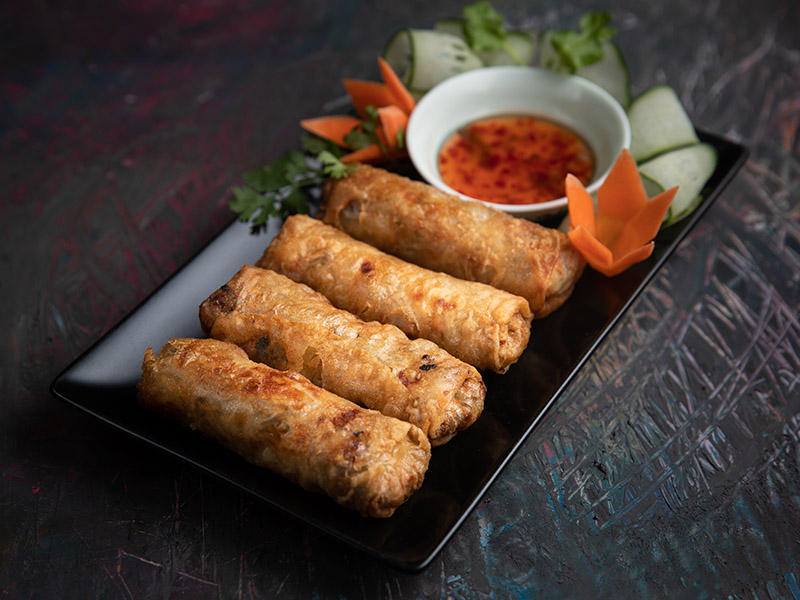
Well-Known Chinese Dishes You Should Not Miss
Chinese cuisine has a big influence on the cuisines of many countries in the world. Their foods impress customers with strong and rich flavor. Here are some typical Chinese dishes you can learn how to cook at home.
Kung Pao Chicken
This classic stir-fried chicken dish originated in Sichuan province in China. Kung Pao chicken contains chicken pieces, roasted peanuts, dried peppers, and Sichuan peppercorns. It is a perfect combination of spicy, salty, and sweet flavors.
Sweet And Sour Pork
Sweet And Sour Pork is an addictive and delicious dish you can cook at home. The crispiness of the pork, the sweetness of sugar, ketchup, and the sourness of canned pineapple juice (or apple cider vinegar) make the dish flavorful.
Chow Mein (Chinese Fried Noodles)
Chow Mein is a favorite of many Chinese or non-Chinese people. It is a traditional noodle dish made from Chinese egg noodles, chicken breast, bean sprouts, bok choy, and other seasonings. Why don’t you try cooking this treat yourself?
Here is a simple guide to cooking Chow Mein.
Mouthwatering Vietnamese Dish Recipes You Must Try
Below are some incredible Vietnamese dishes that many people want to enjoy more than once. So, how about learning to cook them at home? They will make your meals better than ever.
Phở
It is no doubt that Phở is the most famous Vietnamese dish with its delicate and delicious soup. This health-conscious noodle soup will be a perfect choice for your breakfast or any other meal.
Gỏi Cuốn (Vietnamese Fresh Spring Rolls)
This is one of the freshest and easiest Vietnamese recipes you cannot miss. It is a perfect dish for everyday meals or even for gatherings. The rolls with fresh vegetables, tender pork, and shrimp with rice noodles will make your mouth water.
Here is a guide to making fresh and healthy Vietnamese spring rolls with three different types of dipping sauces.
Bánh Xèo (Vietnamese Crepe)
Bánh Xèo is a traditional and popular dish in Vietnam, especially in Central and Southern Vietnam. It wins the heart of many travelers coming to these regions. The fresh vegetables, crispy crepe, and flavorful fillings will keep your mouth water.
FAQs
Do you have any more questions about these two amazing Asian cuisines? Here are some frequently asked questions about Chinese and Vietnamese foods you can refer to.
Both Chinese And Vietnamese Foods Are Delicious And Special
I hope now you learn everything about Chinese and Vietnamese foods. They are two typical Asian cuisines that any visitor will fall in love with. They do share some similarities but also have distinctions that make them unique.
So, which one do you prefer, Chinese foods or Vietnamese foods? I would love to read your thoughts and experiences with these cuisines in the comment section. Do not hesitate to share the blog if you find it useful and informative.
Thank you, and see you soon!
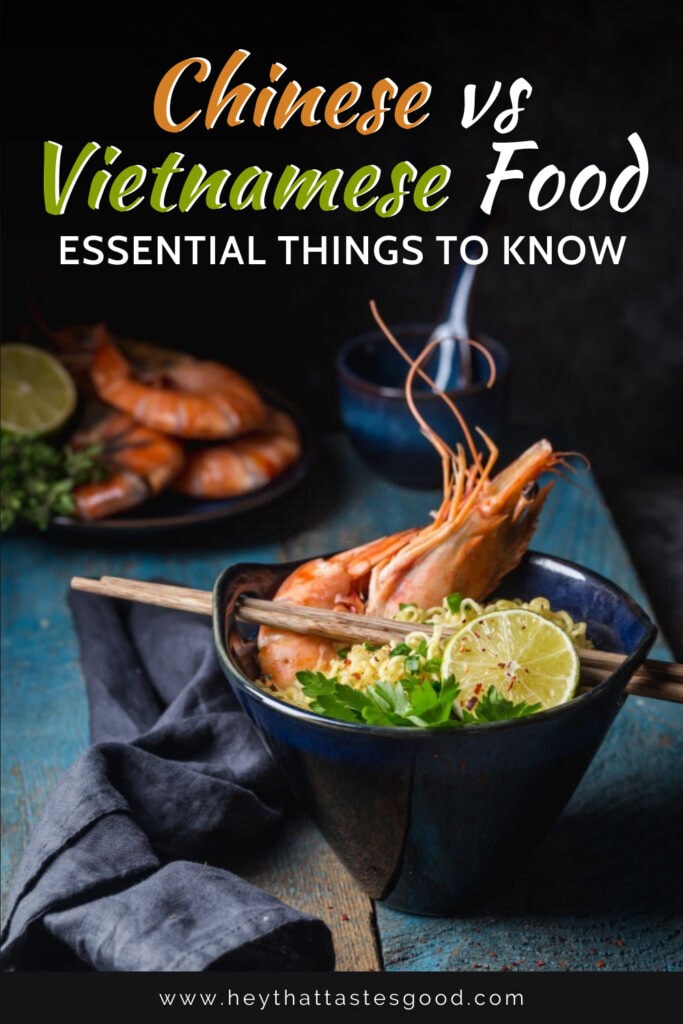
References
- ers.usda.gov. 2022. Rice Sector at a Glance.
- renewacupunctureclinic. 2020. The Five Flavours Of Food According To Traditional Chinese Medicine.


Truc Tran (Kris)
Expertise
Home Cooking, Meal Planning, Recipe Development, Baking and Pastry, Food Editor, Cooking-video Maker, Asian Food Content Creator, Vietnamese Food Evaluation Expert
Education
Program: Diploma of Hospitality (Commercial Cookery)
Focus: The culinary program included a Certificate III in Commercial Cookery, a Certificate IV in Kitchen Management, and a Diploma of Hospitality Management. This education provided a comprehensive blend of theoretical and practical training in finance, sustainability, diversity, and human resources management.
Program: Culinary Arts at Kendall College (Australia Branch in Sydney)
Focus: Explored global cuisines, and developed entrepreneurial abilities to manage a successful food business, along with acquiring essential language, math, computer, and communication skills for success.
Program: Certificate of Vietnamese Cuisine Head Chef
Focus: Master traditional and modern Vietnamese cooking techniques.
Truc Tran, or Kris, is an accomplished food editor with extensive training in hospitality and culinary arts, including a deep focus on Vietnamese cuisine from various prestigious institutions. She possesses over nine years of experience, developing her expertise in global cuisines and blending traditional Vietnamese cooking with contemporary trends to create engaging and educational content.
She also has a rich educational background, including a Diploma of Hospitality from TasTAFE and a Bachelor of Arts in Culinary Arts from Kendall College’s Sydney branch. It enables her to offer unique insights into meal planning, recipe development, and food culture, making her articles and cooking videos both informative and appealing.